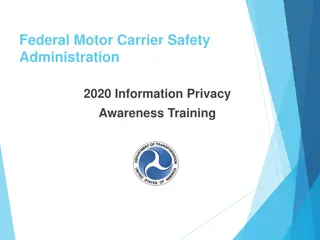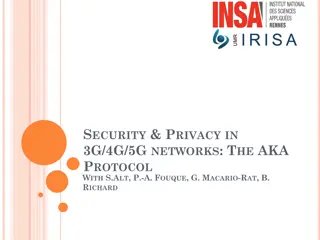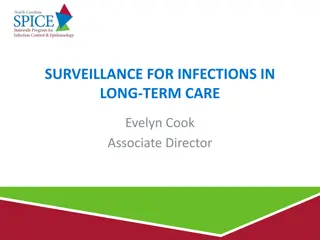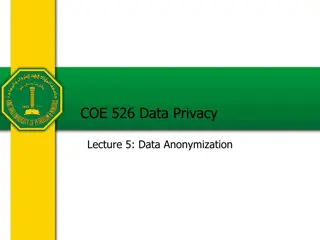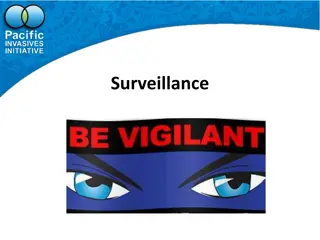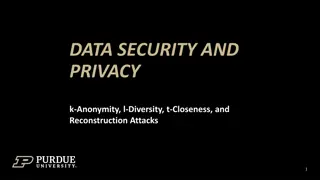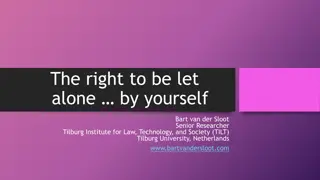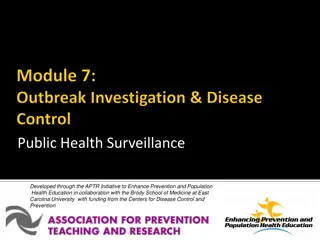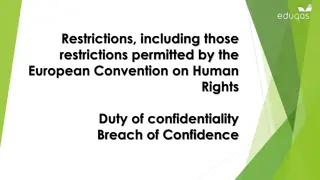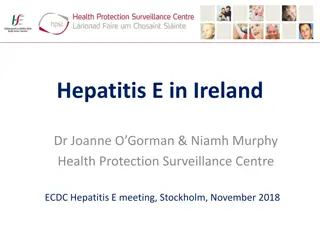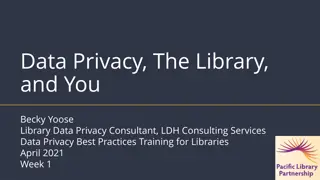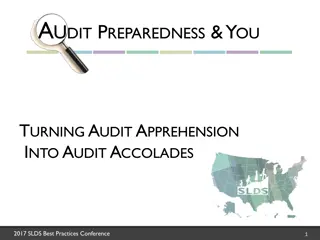Privacy-Preserving Surveillance: Design and Implementation
This project focuses on addressing the lack of accountability and guarantees in traditional surveillance methods by proposing a new approach that replaces secretive law enforcement practices with open privacy policies. The goal is to achieve surveillance with privacy preservation through the use of cryptographic technology, ensuring both national security and personal privacy can coexist.
Download Presentation

Please find below an Image/Link to download the presentation.
The content on the website is provided AS IS for your information and personal use only. It may not be sold, licensed, or shared on other websites without obtaining consent from the author. Download presentation by click this link. If you encounter any issues during the download, it is possible that the publisher has removed the file from their server.
E N D
Presentation Transcript
Design and Implementation of Privacy-Preserving Surveillance Aaron Segal Yale University May 11, 2016 Advisor: Joan Feigenbaum 1
Overview Introduction Surveillance and Privacy Privacy Principles for Open Surveillance Processes Lawful Set Intersection and the High Country Bandits Contact Chaining Anonymity through Tor and Verdict 2
The Problem Open season on private personal data No accountability No guarantees The government is part of the problem 3
Motivation & Goals Replace law enforcement s secretive, unprincipled treatment of citizens big data with an open privacy policy. - Secret processes for data collection - Public is asked to trust the government - Presumed tradeoff between national security and personal privacy - Ideal world: No surveillance 4
Motivation & Goals Replace law enforcement s secretive, unprincipled treatment of citizens big data with an open privacy policy. - Secret processes for data collection - Public is asked to trust the government - Presumed tradeoff between national security and personal privacy Realistic goal: Surveillance with privacy preservation 5
Motivation & Goals Replace law enforcement s secretive, unprincipled treatment of citizens big data with an open privacy policy. - Secret processes for data collection - Public is asked to trust the government No need to abandon personal privacy to ensure national security Realistic goal: Surveillance with privacy preservation 6
Motivation & Goals Replace law enforcement s secretive, unprincipled treatment of citizens big data with an open privacy policy. - Secret processes for data collection Accountability guaranteed by existing cryptographic technology No need to abandon personal privacy to ensure national security Realistic goal: Surveillance with privacy preservation 7
Motivation & Goals Replace law enforcement s secretive, unprincipled treatment of citizens big data with an open privacy policy. Open processes for data collection with a principled privacy policy Accountability guaranteed by existing cryptographic technology No need to abandon personal privacy to ensure national security Realistic goal: Surveillance with privacy preservation 8
Some Privacy Principles for Lawful Surveillance (1) Open processes - Must follow rules and procedures of public law - Need not disclose targets and details of investigations Two types of users: Targeted users - Under suspicion - Subject of a warrant - Can be known or unknown Untargeted users - No probable cause - Not targets of investigation - The vast majority of internet users 9
Some Privacy Principles for Lawful Surveillance (2) Distributed trust - No one agency can compromise privacy. Enforced scope limiting - No overly broad group of users data are captured. Sealing time and notification - After a finite, reasonable time, surveilled users are notified. Accountability - Surveillance statistics are maintained and audited. 11
Case Study High Country Bandits 2010 case string of bank robberies in Arizona, Colorado FBI Intersection attack compared 3 cell tower dumps totaling 150,000 users 1 number found in all 3 cell dumps led to arrest 149,999 innocent users information acquired 12
Intersecting Cell-Tower Dumps Law enforcement goal: Find targeted, unknown user whose phone number will appear in the intersection of cell-tower dumps Used in: High Country Bandits case, CO-TRAVELER program - Same principle for any collection of metadata Cell Tower B Time t2 Cell Tower C Time t3 Cell Tower A Time t1 650-555-4430 650-555-3435 650-555-2840 650-555-7691 650-555-1505 650-555-9589 650-555-7976 650-555-9266 650-555-3222 650-555-3813 650-555-2786 650-555-7976 650-555-0392 650-555-5872 650-555-4891 650-555-9709 650-555-7928 650-555-0599 650-555-6445 650-555-7511 650-555-2277 650-555-7976 650-555-2840 650-555-3222 13
Intersecting Cell-Tower Dumps Law enforcement goal: Find targeted, unknown user whose phone number will appear in the intersection of cell-tower dumps Used in: High Country Bandits case, CO-TRAVELER program - Same principle for any collection of metadata Cell Tower B Time t2 Cell Tower C Time t3 Cell Tower A Time t1 650-555-4430 650-555-3435 650-555-2840 650-555-7691 650-555-1505 650-555-9589 650-555-7976 650-555-9266 650-555-3222 650-555-3813 650-555-2786 650-555-7976 650-555-0392 650-555-5872 650-555-4891 650-555-9709 650-555-7928 650-555-0599 650-555-6445 650-555-7511 650-555-2277 650-555-7976 650-555-2840 650-555-3222 14
Privacy-Preserving Solution [SFF, FOCI14] A private set intersection protocol built to satisfy surveillance privacy principles (based on Vaidya-Clifton 05) Catching Bandits and Only Bandits: Privacy-Preserving Intersection Warrants for Lawful Surveillance - Presented at the 4thUSENIX Workshop on Free and Open Communications on the Internet (FOCI '14) 15
Privacy-Preserving Cryptography Probabilistic ElGamal encryption for secure storage of cell-tower records. - Same records encrypt to different random-looking byte strings Deterministic Pohlig-Hellman encryption for temporary, per- execution blinding of those records. - Same records encrypt to identical random-looking byte strings a = "650-555-2840" b = "650-555-2840" print ElGamalEncrypt(a) > 0x00d07e08ec44712b print ElGamalEncrypt(b) > 0x58c82a7f050f9683 a = "650-555-2840" b = "650-555-2840" print PohligHellmanEncrypt(a) > 0x0cb508480f207ec5 print PohligHellmanEncrypt(b) > 0x0cb508480f207ec5 16
Private Set Intersection Setup ElGamal encryption and Pohlig-Hellman encryption are mutually commutative with one another D2(D3(D1(E3(E2(E1(x)))))) = x D3(D2(E3(D1(E2(E1(x)))))) = x Relies on multiple, independent agencies to execute protocol, providing distributed trust and accountability, e.g.: - Executive agency (FBI, NSA) - Judicial agency (warrant-issuing court) - Legislative agency (oversight committee established by law) Each agency must participate at each step or else no one can decrypt! 17
Private Set Intersection Protocol (Step 1) Repository serves data encrypted with ElGamal encryption - Uses agencies long-term public (encryption) keys E3(E2(E1(x))) Agencies encrypt the encryptions with Pohlig- Hellman encryption Uses agencies ephemeral encryption keys Agencies decrypt the encrypted encryptions with ElGamal decryption - Uses agencies long-term private (decryption) keys 1 2 3 Can now inspect data, which is encrypted under Pohlig-Hellman 18
Private Set Intersection Protocol (Step 1) Repository serves data encrypted with ElGamal encryption - Uses agencies long-term public (encryption) keys 1 2 3 Agencies encrypt the encryptions with Pohlig- Hellman encryption - Uses agencies ephemeral encryption keys E3(E2(E1(E3(E2(E1(x)))))) Agencies decrypt the encrypted encryptions with ElGamal decryption Uses agencies long-term private (decryption) keys 1 2 3 Can now inspect data, which is encrypted under Pohlig-Hellman 19
Private Set Intersection Protocol (Step 1) Repository serves data encrypted with ElGamal encryption - Uses agencies long-term public (encryption) keys 1 2 3 Agencies encrypt the encryptions with Pohlig- Hellman encryption - Uses agencies ephemeral encryption keys E3(E2(E1(x))) Agencies decrypt the encrypted encryptions with ElGamal decryption - Uses agencies long-term private (decryption) keys Can now inspect data, which is encrypted under Pohlig-Hellman 20
Private Set Intersection Protocol (Step 2) Accomplished: Moved from an ElGamal state to a Pohlig-Hellman state without ever fully decrypting the private data! Agencies can now inspect encrypted data to find matching records Last step: decrypt only those records with Pohlig-Hellman a = "650-555-2840" b = "650-555-2840" print ElGamalEncrypt(a) > 0x00d07e08ec44712b print ElGamalEncrypt(b) > 0x58c82a7f050f9683 a = "650-555-2840" b = "650-555-2840" print PohligHellmanEncrypt(a) > 0x0cb508480f207ec5 print PohligHellmanEncrypt(b) > 0x0cb508480f207ec5 21
Protocol Satisfies Privacy Principles Open Process - Can openly standardize the protocol and the crypto without compromising investigative power Distributed trust - No one agency can decrypt or perform intersection. Enforced scope limiting - Any agency can stop an execution if sets or intersection are too large. Sealing time and notification - Implementable by policy all agencies get final data set Accountability - Because every agency must participate, no agency can perform illegitimate surveillance without the other agencies learning and getting statistics. 22
Evaluation of Implementation Java implementation of protocol run in parallel on Yale CS Cloud High Country Bandits example with 50,000 items per set takes less than 11 minutes to complete. Note that this is an offline process. 23
Contact Chaining Government knows phone number of target X. Goal: Consider the k-contacts of X (nodes within distance k). x 24
Privacy-Preserving Contact Chaining Goals Government learns actionable, relevant intelligence Telecommunications companies learn nothing more about other companies clients x 25
Privacy-Preserving Contact Chaining Goals Government learns actionable, relevant intelligence Telecommunications companies learn nothing more about other companies clients 26
Privacy-Preserving Contact Chaining Goals Government learns actionable, relevant intelligence Telecommunications companies learn nothing more about other companies clients 27
Restrictions on Contact Chaining Respect the distinction between targeted and untargeted users Enforce scope limiting Enforce division of trust between authorities 28
Using Contact Chaining - Main Idea Use privacy- preserving contact chaining protocol to get encryptions of k-contacts of target Use privacy- preserving set intersection to filter k-contacts and decrypt only new targets 650- 555- 7976 29
Privacy-Preserving Contact Chaining Protocol Government agencies agree on a warrant: - Initial target id X - Maximum chaining length k - Scope-limiting parameter d : Maximum degree Each telecom has: - List of client identities served - Contact list for each client Agencies repeatedly query telecoms about their data 30
Privacy-Preserving Contact Chaining Protocol Setup Agencies perform a modified parallel breadth-first search by querying telecoms Query to T(a) EncT(a)(a) Signatures from all agencies EncT(a)(a) is a public-key encryption of a under the encryption key of T(a), the telecom that serves user a Response from T(a) EncAgencies(a) EncT(b)(b) for all b in a s set of neighbors Signature from T(a) EncAgencies(a) is an ElGamal encryption of a under the keys of all agencies 31
Privacy-Preserving Contact Chaining Protocol Step 0: - Query T(x) on original target x Query to T(a) EncT(a)(a) Signatures from all agencies Step 1 through k: - Query appropriate telecom on all ciphertexts received during previous step - Exception: If a single response has more than d contacts, do not query them Response from T(a) EncAgencies(a) EncT(b)(b) for all b in a s set of neighbors Signature from T(a) Output: Agency ciphertexts received 32
Protecting Private Data Agencies see no cleartext identities from this contact chaining protocol Query to T(a) EncT(a)(a) Signatures from all agencies Telecoms learn no information about other telecoms users by responding to queries Response from T(a) EncAgencies(a) EncT(b)(b) for all b in a s set of neighbors Signature from T(a) Signatures ensure validity of all messages 33
Protocol Satisfies Privacy Principles Open Process - Can openly standardize the protocol and the crypto without compromising investigative power Distributed trust - Telecoms disregard queries unless signed by all agencies - No one agency can decrypt responses Enforced scope limiting - Any agency can block paths through high-degree vertices Sealing time and notification - Agencies can notify targeted users after intersection step Accountability - Surveillance statistics collected by any or all agencies 34
Contact Chaining Experimental Setup Java implementation of protocol run in parallel on Yale CS Cloud Ciphertexts in result Degree of Target x 40 47 128 123 32 40 230 159 128 123 Maximum Path Length k 2 2 2 2 3 3 3 3 3 3 Large Vertex Degree Cutoff d 50 75 150 500 200 150 100 150 500 500 582 1061 5301 10188 27338 49446 102899 149535 194231 297474 Used actual network data from a Slovakian social network as realistic stand-in for a telephone network 36
Contact Chaining Experimental Results Varied starting position, k, and d to examine a variety of neighborhood sizes Ciphertexts in result End-to-end runtime MM:SS 00:05 00:06 00:23 00:37 01:50 03:15 07:43 10:25 13:57 21:51 Telecom CPU Time H:MM:SS 0:00:32 0:00:57 0:04:43 0:08:41 0:28:23 0:46:28 1:58:16 2:42:49 3:34:48 5:41:43 Bytes transferred MB 18 6 22 36 132 222 804 896 978 1570 582 1061 5301 10188 27338 49446 102899 149535 194231 297474 Measured - End-to-end running time - CPU time used by all telecoms - Total bandwidth sent over network 37
Privacy-Preserving Contact Chaining and Intersection Privacy-preserving contact chaining & set intersection together Our principles apply to other surveillance of private data No need for new cryptographic tools, backdoors, or secret processes 39
Anonymity: Users Protecting Themselves With Tor Anonymous communication dissociates network activity from user identity Tor: The Second-Generation Onion Router [DMS 2004] - 2 million Tor users daily - 7000+ volunteer relays in the Tor network Connections made through three relays: guard, middle, exit Vulnerability: Adversary who can view guard and exit traffic together 40
TorFlow: Critical but Vulnerable TorFlow conducts bandwidth scans to measure all 7000+ relays Relays can determine when they re being scanned - Exploit: Give better service to measurement authorities Bandwidth scans use only two relays, not three - Exploit: Launch DoS on another relay by blocking traffic only when on a circuit with that relay Results of scans are used only to proportionally adjust self-reported measurements - Exploit: Lie 41
PeerFlow: Secure Load Balancing Alternative Periodically estimate relay bandwidth and use estimates to calculate selection weight Three estimates of relay bandwidth: 1. Measurements collected from relays about other relays Use natural traffic to generate measurements Ignore measurements made by smaller relays Add random noise to measurements before sending 2. Self-reports from relays Relays report estimate of own capacity Reports are not trusted 3. Expected traffic carried Based on selection weight in last measurement period 42
PeerFlow: High-level Idea Use estimates to choose relay selection weight - Selection weight ~= fraction of traffic carried If measured bandwidth expected bandwidth and self-reported bandwidth > measured bandwidth: Increase selection weight If measured bandwidth < expected bandwidth and self-reported bandwidth > measured bandwidth: Decrease selection weight in next period to be equal to measured bandwidth in that period 43
Verdict: Alternative to Tor Verdict: accountable anonymity through Dining-Cryptographers Networks (DC-Nets) - Original paper: Henry Corrigan-Gibbs, David Isaac Wolinsky, Bryan Ford (USENIX 2013) Not vulnerable to an adversary, even if they can view all messages Trade-off: Users take turns sending messages over network, increasing latency Proof of security! 45
Verdict Architecture Multi-provider cloud - Each client connected with one or more servers - Each server connected with all other servers Anytrust - At least one server is honest 46
Verdict Properties Proven Accountability - Whenever the protocol fails, an honest node can produce a proof that shows a deviation from the protocol on the part of one other participant - A dishonest participant can t produce a proof blaming an honest participant With every message, each participant sends a non-interactive zero- knowledge proof that the sender is following the protocol Anonymity Integrity 47
Verdict Properties Proven Accountability Anonymity - As long as there are two honest clients, no other participant can tell which client sends which message, even if they can see all messages being sent over the wire Adversary can t distinguish between encryptions of messages without breaking security of underlying encryption scheme or zero-knowledge property of proof scheme Integrity 48
Verdict Properties Proven Accountability Anonymity Integrity - Either all clients receive accurate messages from all other clients, or all clients know that the protocol failed - Forging or altering messages is impossible Straightforward as long as E(m)+E(0)+E(0)+E(0)+... = E(m) and proofs of knowledge can t be forged 49
Conclusions Privacy-preserving surveillance is technologically feasible Privacy-preserving set intersection and contact chaining can accomplish law-enforcement goals with open processes and without users losing control of their data Anonymity through Tor is practical and can be secured against bandwidth-inflation attacks using PeerFlow Verdict offers provably accountable anonymity as alternative to Tor 50
Thank you! 51




